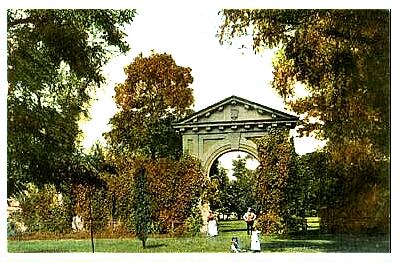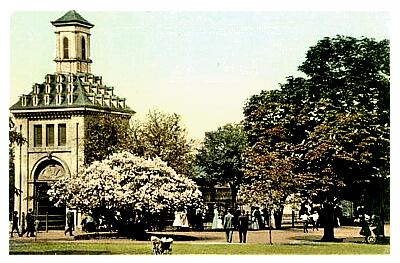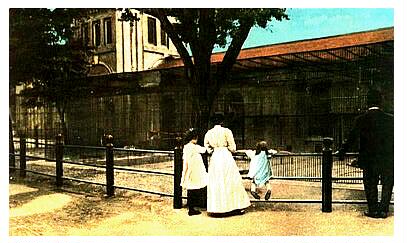
ONTARIO

Dundurn
NO PART OF THE FOLLOWING
ARTICLE AND PHOTOGRAPHS
MAY BE REPRODUCED WITHOUT
PERMISSION FROM THE AUTHOR ©
Dundurn Park began as Burlington Heights which was close to Hamilton Harbour. It was first owned by Colonel Richard Beasley who was a city business owner and politician. In 1799 he built a house, barns, storehouse, wharf, and some other buildings on the almost-400 hectare property. The land changed hands a few times and ended up in 1832 with Allan McNab who had made his fortune in railroads. His improvements to the property included the building of a $175,000 villa, of which the front wall and door were originally part of Beasley's second home. The villa contained 72 rooms, 17 of which had fireplaces, and it looks like a castle because of its dual towers. It was completed in 1835 and was the largest building in Ontario (then Upper Canada) at that time. A Coach House, The Cockpit Theatre, and Gardener's Cottage, all of which remain today, were also McNab improvements.
An interesting trivia fact is that McNab was Camilla Shand's great-great-great-grandfather through his second wife. She is currently the Dutchess of Cornwall and married to Prince Charles, the heir to the British throne. Both royals visited the castle in 2009 on November 5th.
|
Dundurn Castle Undated 
|
| A tinted postcard shows the grounds and castle. |
The land changed hands several more times, throughout which the city was offered on occasion to purchase it. They declined each time. By 1872 it belonged to Donald MacInnes, later to become director of The Canadian Pacific Railway. Six years later he leased an area surrounding Dundurn Castle to Richard Benner and James Howard. They opened a fenced 13-hectare area to the public on July 27, 1878. Citizens would use York Street (now boulevard) to access the park's entrance where they were charged admission to the grounds upon which they enjoyed concerts and theatrical presentations. The park would play host to many picnics and music festivals over the next few years as patronage increased.
|
Dundurn Park Entrance Late 1890s or Early 19-0s 
|
| This shows the gate about 25 years after the park went public. |
|
Here is an image of the old
gate to the park after the
vegetation had been removed.
|
The Park's Entrance Mid 19-0s  |
One of the big draws at the park were fireworks displays by a Professor Thomas Hand. The works were arranged in elaborate patterns and stunts. For one performance in 1880, Hand had a "Fire King" descend from the top of the castle to the lawn below, a distance of about 90 metres. THe King was in a flaming chariot drawn by two fiery dragons.
Additional attractions were added as the park's popularity grew. These included dancing, a performance stage, sports such as cricket, baseball, quoits, and lacrosse, hot air balloon rides by Professor Williams, and eventually a zoo. Also, at some point a bowling alley was installed in the castle. The park was popular: In the early 1880s, over four dozen organisations booked picnics there.
In 1885, a baseball ground was established. It was constructed next to the castle in an area previously occupied by gardens. A section was fenced off, the trees & plants were removed, grass put down, and a score board, 650-seat grandstand, and a protective barrier behind home plate were installed. A Canadian Baseball League home team, The Hamilton Clippers would be based there. It proved popular enough that in 1886, the grandstand seating capacity and the playing surface were increased, a fence was erected around the field and the existing gardner's building on the grounds was renovated to become the home team's clubhouse and locker/shower facility.
Being next to Dundurn Castle was a benefit because alcohol could not be consumed at a baseball park after 1887, but the castle had a pub. As well, the park itself had a beer & cigar stand at least as early as 1885. By the late 1880s, it would not be unusual for a baseball game to draw 1,500 patrons.
Dundurn had one of Canada's first roller coasters. It was called The "Scenic Railway". This was opened August 8th, 1885 (incorrectly stated as 1895 in some sources), and was one of the first coasters with a lift hill & circular layout that returned riders back to their starting position. It was situated on a bank beyond an area known as the "west lawn" and cost 5 cents per ride.
The ride was apparently only about 9 metres high, 152 metres in length, and took 8 seconds to ride. I suspect that the 8-second specification may be wrong. A 150-metre long track only 9 metres high would take about 12 seconds to ride with no additional hills or speed loss. Since the ride is always losing momentum after the initial drop and there is friction & wind resistance, the ride time should be considerably longer. The other alternative is that the height and/or length is wrong. Using the 9-metre height as a drop gives a lossless top speed of about 48 km/h.
The Toronto Exhibition (later, The Canadian National Exhibition) had a similar ride that was installed earlier in 1885, although it's likely that the Dundurn coaster was open to the public first. The Toronto coaster and a second, but different, model appear in Exhibition brochures and eproductions of the era. (Publications dated 1886 and 1891 both show at least one coaster.)
I don't have the name of the designer/builder of either of these rides, but Charles Alcoke installed a ride at Coney Island, New York in 1884 that was one of the first modern coasters to have a continuous layout. It's possible that both The CNE's and Dundurn's were built by, or copied from, Alcoke. (Note too, that The Toronto Exhibition also had a Switchback roller coaster installed in 1885, so they had two roller coasters.)
Another possible builder of the Dundurn coaster may be Philip Hinkle (also spelled in some references as "Phillip Hinckle"). He opened a continuous-circuit coaster at Coney Island in 1885 which featured an elliptical track and a hoist to return cars to the top of the main hill. Since the Dundurn coaster opened in 1885, it too may be a Hinkle creation, although I have no reference as to how the cars were returned to the top of the first drop on this ride.
No date has surfaced for when Dundurn's ride was removed, but it likely lasted into the 1890s but not much beyond. This is based upon the fact that postcards for this park seemed to date from the early 19-0s, yet none have surfaced with an image of what was surely one of the park's premier attractions. (See the Brighton Beach article for another possible Alcoke or Hinkle creation.)
Alan Sutherland, of Ontario, says that a miniature railway was added to this park in 1888. The ride was built by his grandfather, Ernest George Yeates. He would go on to develop Springbank as the water supply for London in the early 1900s. The Dundurn ride would later be transferred to the amusement park there. (See Springbank Park.)
The park's growth prompted the Hamilton Street Car Company to place a double track to the park from James Street along York to provide service to the new improvements. This occurred around 1885. However, a later (1929) request to place a turn-around loop in the park was denied. In fact, although there were rail tracks between Dunurn's water-side boundary and the harbour, over the years, requests made to place tracks through the park by various streetcar and railway companies were always turned down.
|
Park Bridge 19-0s 
|
| This is one of the many paths in the wooded areas of the park. |
Unfortunately, baseball, which drew many to the park, was not to last. In October 1899, the city finally bought the park (for $50,000) and council decided that baseball should not be played in such a historic area. They closed the field by 1902. Despite the looming possibility of no baseball in subsequent years, people flocked to the now city-owned park's season opening on Victoria Day, May 24th, 1900. Events included a parade, a school choir concert, and other exciting activities. The day was capped off with fireworks.
After the sale, a larger zoo was opened with many birds and animals. However, as the park deteriorated in later years, the zoo was not kept up and many animals and birds died. By April 1928, the zoo was closed and replaced with an aviary. This grew to have over 50 different species with more than 1,000 birds. It lasted until 1995 when Churchill Park Community Gardens became the aviary's new home.
|
The Zoo Entrance 19-0s 
|
|
The Zoo Interior 19-0s 
|
Even after the demise of baseball at the park, the area was used for recreation. Attempts were made over the years to supply swimming facilities to the park's patrons by buying or leasing the beach area on the harbour side of the railroad tracks. Despite even the fact that the railroad changed owners, no agreement was ever reached. The first definite plan to form a beach was suggested in 1918 by Alderman T. M. Wright. His plan would cost $25,000 and consisted of upgrading the beach area, plus access under the railroad tracks via a tunnel from the park.
In 1924, two plans were proposed. One suggested having a bathhouse with an 800-metre boardwalk that would be reached by an overhead walkway allowing park goers access to the facilities. Charles Heming submitted a plan to build a bathhouse with a boathouse & bathing facilities on one floor, a restaurant on a second, and on top, a roof garden with open-air dancing. In all cases the railroad would not allow a lease of the beach for longer than a year, nor allow crossing of the tracks (whether under or over) even after the railroad was publicly owned by 1924.
No information has surfaced on the middle period of this park yet, although in 1935, the Castle was opened for museum exhibitions. It closed sometime between 1964 and 1967 when the Castle was renovated. 1961 saw a proposal to have a swimming pool and skating rink built, but it was never approved. The restored Dundurn Castle reopened June 17, 1967 and in August 1977 it was given a "National Treasure" designation under the Ontario Heritage Act.
I have no information for the later years of the park either, but at some point the area ceased to be an amusement park and took on a greater historical significance. By 1992, the Ministry of the Environment recognised it as a restored 19th-century park. Today the park is only permitted to have events of historical significance and to be used as a nature park.
Current facilities are now limited to:
An Archway Main Entrance Gate
Artillery Pieces and Field Cannon
Benches
Coach House
Cockpit Theatre
Dundurn Castle
Gardener's Cottage
Hamilton Military Museum (in the Battery Lodge)
Historical Plaques
Pavilion
Picnic Tables
Playground
Shelters
Sundial
Walkways
|
Thanks to Janet Forjan, Historical Interpreter at Dundurn Castle, for
usage of postcard images of the park. For more pictures, see: |
Return to the
Closed Canadian Parks Index
